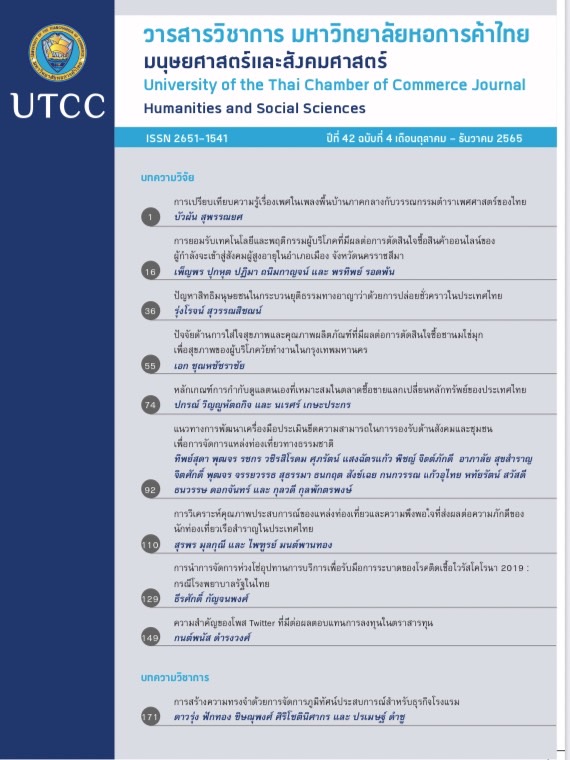The Analysis of Destination Experience Quality and Satisfaction towards Destination Loyalty for Cruise Passengers in Thailand
Main Article Content
Abstract
This research aims to analyze destination experience quality which affects satisfaction towards destination loyalty for cruise passengers in Thailand. The data were collected at Southern ports of Thailand, Phuket Port and Samui Port, from 440 foreign tourists who had experienced onshore excursions. The purposive sampling was used to identify the sample. A questionnaire
was used as a data collection tool. The data analysis was performed by using confirmatory factor analysis and structural equation model analysis. The findings revealed that destination experienc equality positively influenced on destination satisfaction and destination loyalty. Meanwhile, destination satisfaction positively influenced on destination loyalty. Consequently, destination managers should establish a higher destination satisfaction to create destination loyalty, by developing diverse attractions, improving tourism infrastructure, and enhancing the tourism environment such as
the standard of hygiene and cleanliness at destinations. The practical implications may further enhance tourists’ satisfaction, as well as their intention to revisit this destination as land-based tourists and to give positive recommendations to others.
Article Details

This work is licensed under a Creative Commons Attribution-NonCommercial-NoDerivatives 4.0 International License.
ลิขสิทธิ์ของบทความ
ผลงานที่ได้รับการตีพิมพ์ถือเป็นลิขสิทธิ์ของมหาวิทยาลัยหอการค้าไทย ห้ามมิให้นำเนื้อหา ทัศนะ หรือข้อคิดเห็นใด ๆ ของผลงานไปทำซ้ำ ดัดแปลง หรือเผยแพร่ ไม่ว่าทั้งหมดหรือบางส่วนโดยไม่ได้รับอนุญาตเป็นลายลักษณ์อักษรจากมหาวิทยาลัยหอการค้าไทยก่อน
References
Anderson, J. C., & Gerbing, D. W. (1988). Structural equation modeling in practice: A review and recommended two-step approach. Psychological bulletin, 103(3), 411.
Andriotis, K., & Agiomirgianakis, G. (2010). Cruise visitors’ experience in a Mediterranean port of call. International Journal of Tourism Research, 12(4), 390-404.
Backman, S. J., & Crompton, J. L. (1991). The usefulness of selected variables for predicting activity loyalty. Leisure sciences, 13(3), 205-220.
Beerli, A., & Martin, J. D. (2004). Factors influencingdestination image. Annals of Tourism Research,31(3), 657-681.
Brida, J. G., Pulina, M., Riaño, E., & Zapata-Aguirre, S. (2012). Cruise visitors’ intention to return as land tourists and to recommend a visited destination. Anatolia, 23(3), 395-412
Chen, C.-F., & Chen, F.-S. (2010). Experience quality, perceived value, satisfaction and behavioral intentions for heritage tourists. Tourism Management, 31(1), 29-35.
Cole, S. T., & Scott, D. (2004). Examining the mediating role of experience quality in a model of tourist experiences. Journal of Travel & Tourism Marketing, 16(1), 79-90.
Crompton, J. L., & Love, L. L. (1995). The predictive validity of alternative approaches to evaluating quality of a festival. Journal of Travel Research, 34(1), 11-24.
Cruise Lines International Association. (2018a). Asia cruise trends 2018 edition. Retrieved from https://cruising.org/-/media/research-updates/research/asia-cruise-trends/asia-cruise-trends-2018.ashx
Cruise Lines International Association. (2018b, DECEMBER 13). Cruise travel trends and state of
thecruiseindustryoutlook [Press Release]. Retrievedfrom https://cruising.org/en/news-and- research/press-room/2018/december/2019-cruise-travel-trends-and-state-of-the-cruiseindustry-outlook
Cruise Lines International Association. (2020). 2020 Asia cruise deployment & capacity report. Retrieved from https://cruising.org/-/media/clia-media/research/2021/oneresource/2020-asia-cruise-deployment-and-capacity-report.ashx
Cutler, S. Q., & Carmichael, B. A. (2010). The dimensions of the tourist experience. In M Morgan, P Lugosi, & B Ritchie (Eds.), The experience of tourism and leisure: Consumer and managerial perspectives (pp. 3-26). Bristol, UK: Channel View Publications.
Feng, Y., Chen, X., & Lai, I. (2020). The effects of tourist experiential quality on perceived value and satisfaction with bed and breakfast stays in southwestern China. Journal of Hospitality and Tourism Insights, 4(1), 121-135. doi: 10.1108/jhti-02-2020-0015
Hair, J. F., Ringle, C. M., & Sarstedt, M. (2011). PLS-SEM: Indeed a silver bullet. Journal of Marketing Theory and Practice, 19(2), 139-152. doi: 10.2753/MTP1069-6679190202
Jin, N., Lee, S., & Lee, H. (2015). The effect of experience quality on perceived value, satisfaction, image and behavioral intention of water park patrons: New versus repeat visitors. International Journal of Tourism Research, 17(1), 82-95.
Kao, Y.-F., Huang, L.-S., & Wu, C.-H. (2008). Effects of theatrical elements on experiential quality and loyalty intentions for theme parks. Asia Pacific Journal of Tourism Research, 13(2),163-174.
Keller, K. L. (1993). Conceptualizing, measuring, and managing customer-based brand equity. Journal of marketing, 57(1), 1-22.
Larsen, S., Marnburg, E., & Øgaard, T. (2012). Working onboard – Job perception, organizational commitment and job satisfaction in the cruise sector. Tourism Management, 33(3), 592-597. doi: 10.1016/j.tourman.2011.06.014
Maklan, S., & Klaus, P. (2011). Customer experience: are we measuring the right things? International Journal of Market Research, 53(6), 771-772.
Meng, S.-M., Liang, G.-S., & Yang, S.-H. (2011). The relationships of cruise image, perceived value, satisfaction, and post-purchase behavioral intention on Taiwanese tourists. African Journal of Business Management, 5(1), 19-29.
Monpanthong, P. (2018). Efficiency of cruise port management: A comparison of Phuket and Singapore. Pertanika Journal of Social Sciences & Humanities, 26(4), 2787-2808.
Retrieved from http://www.pertanika.upm.edu.my/resources/files/Pertanika%20PAPERS./ JSSH%20Vol.%2026%20(4)%20Dec.%202018/38.%20JSSH-2268-2017.pdf
Morgan, M., Lugosi, P., & Ritchie, J. R. B. (2010). The tourism and leisure experience: consumer and managerial perspectives. Bristol, UK: Channel View Publications.
Petrick, J. F. (2004). First timers’ and repeaters’ perceived value. Journal of Travel Research, 43(1), 29-38
Ramseook-Munhurrun, P., Seebaluck, V. N., & Naidoo, P. (2015). Examining the structural relationships of destination image, perceived value, tourist satisfaction and loyalty: Case of Mauritius. Procedia - Social and Behavioral Sciences, 175, 252-259.
Sanz Blas, S., & Carvajal-Trujillo, E. (2014). Cruise passengers’ experiences in a Mediterranean port of call. The case study of Valencia. Ocean & Coastal Management, 102, 307-316.
Toudert, D., & Bringas-Rábago, N. L. (2016). Impact of the destination image on cruise repeater’s experience and intention at the visited port of call. Ocean & Coastal Management, 130,239-249.
Westbrook, R. A. (1980). A rating scale for measuring product/service satisfaction. Journal of marketing, 44(4), 68-72.
Wu, H.-C., Li, M.-Y., & Li, T. (2018). A study of experiential quality, experiential value, experiential satisfaction, theme park image, and revisit intention. Journal of hospitality & tourismresearch, 42(1), 26-73
Yeo, G. T., Thai, V. V., & Roh, S. Y. (2015). An analysis of port service quality and customer satisfaction: The case of Korean container ports. The Asian Journal of Shipping and Logistics, 31(4), 437-447.
Yoon, Y., & Uysal, M. (2005). An examination of the effects of motivation and satisfaction on destination loyalty: a structural model. Tomodel. Tourism Management, 26(1), 45-56


